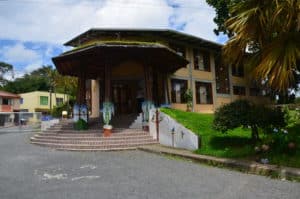Last updated on .
The UTP Botanical Garden (Jardín Botánico UTP) is located in Pereira. It’s operated by Universidad Tecnológica de Pereira and is located on their campus.
Admission
The garden is open daily for tours given by English-speaking university students. It’s open Monday through Friday from 8am to 4pm and on weekends from 9am to 2pm. Admission for foreigners is a flat fee of COP$50,000 for one to three people and COP$20,000 per person for groups of four or more (as of June 2023). You can buy your tickets at the main office building just inside the entrance. The tour takes between 90 minutes and two hours.

About the Garden
It isn’t your typical botanical garden with organized sections of flowers and trees, but instead is a wild forest that the university uses to study plant life. It does, however, offer a nice introduction to biodiversity in Colombia and a chance to see several of the countries native plants, insects, animals, and birds. 168 species of birds alone have been spotted in the small space of the garden.
The entire loop path is mostly on concrete, which can get slippery at times. Good walking shoes are recommended. Also be aware that there are lots of steps and it’s about 2km of walking.
First Section
Along the first section of the path, the guide will point out several important plants and explain their unique properties. We were able to see a type of palm with spikes on the trunk, a rubber tree, and the Colombian version of poison ivy.
The most beautiful tree we saw was the guayacán, which only flowers in may. We weren’t able to see any in full bloom but we could see the yellow buds of the flowers.
We were also able to learn about the historical significance of the botanical garden. After the garden was formed, the university conducted archaeological digs to see if they could find evidence of the Quimbaya people that once inhabited the area. Shards of pottery, arrowheads, and other items were found in a small hole that’s still visible today.
Before finishing the first section, the guide talked about the different animals that live in the garden. Some are migratory birds, but several are native to Colombia. Poisonous frogs, several insects, and snakes call the garden home, and it’s also possible to spot mammals such as lemurs and possum. A few of the animals are pictured on interpretive panels.
Second Section
The second section of the path continued down several steps to a platform overlooking a wetland. From there, it’s possible to spot turtles, small fish, and the occasional snake.
Third Section
The third and final section of the path was over a small bridge and up to a guadua forest. Guadua is a type of bamboo native to Colombia and stronger than typical bamboo. We learned how and when to cut it for use in construction, myths and traditions about guadua from locals, and some of the important properties.
Around the guadua forest, we also got to see some critters crawling around the ground.
Other Areas
Finally, after we finished the tour, we were able to visit a reception area near the university’s bridge made of guadua and a hummingbird observation area.
Conclusion
Overall, it was an enjoyable walk through the UTP Botanical Garden with a knowledgable guide. We learned a lot of things we hadn’t known from our experiences at other botanical gardens in Colombia, such as Jardín Botánico de Quindío and Recinto del Pensamiento. Again, it’s not your typical botanical garden, but it’s worth visiting when in Pereira to see a small section of a true Andean forest.